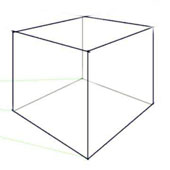he first step towards good sketching is mastering the line. This will lead to good line quality through better mind-body coordination for fluent and confident hand movement when you begin to draw more complex objects, especially in perspective.
Exercise 1:
Improving line quality and control over the pressure applied while drawing.
Posture Tip:
Make use of your full hand as well as your body movements to draw the line.
• Draw a straight line across the sheet.
• Draw the next line parallel to the first line and continue this until you complete the page, as in Fig. 6.

Fig. 6: Straight Horizontal Lines.
• Repeat this exercise as many times till you feel that the quality of your lines have improved. As you grow more confident, try reducing the gap between your lines, as shown in Fig. 7.
Fig. 7: Closely spaced Straight Horizontal Lines.
• The next step would be to practice the same thing with verticals (Refer Fig. 8) and diagonals (Refer Fig. 9).

Fig. 8: Straight Vertical Lines.

Fig. 9: Diagonal Lines.
Examples:
Exercise 2:
Improving consistency and sense of proportion in the line.
• Repeat the same process mentioned above, but this time, do it with a pattern such as a sinusoidal curve, spring and the like, as shown in Fig 10.

Fig. 10: Pattern Lines.
Examples:






















